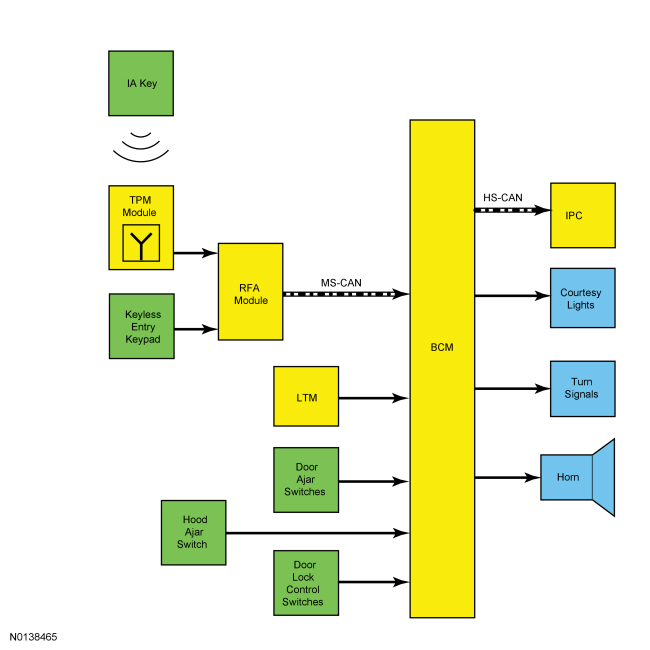SECTION 419-01A: Anti-Theft — Perimeter
| 2014 Flex Workshop Manual
|
DESCRIPTION AND OPERATION
| Procedure revision date: 05/02/2013
|
Overview
The perimeter alarm system deters unauthorized entry to the vehicle by sounding the horn and flashing all the turn signals and interior courtesy lamps when an unauthorized entry occurs. The horn and lamps activate for 30 seconds. After 30 seconds, the horn stops sounding, but the lamps continue to flash for up to 5 minutes.
The panic alarm operates similar to the perimeter alarm, but is only controlled by the panic button on a RKE transmitter. Refer to Section 501-14B for panic alarm operation.
System Operation

Network Message Chart
BCM Network Input Messages
| Broadcast Message | Originating Module | Message Purpose |
|---|---|---|
| Lock request with intelligent access | RFA module | The RFA module monitors door lock/unlock requests (input from the DDM and BCM ), the RKE transmitters and the IA system. Depending on the lock status provided by the RFA module, the BCM arms/disarms the perimeter alarm. |
| RKE data (with intelligent access) | RFA module | The BCM uses this information to activate the panic alarm. |
IPC Network Input Messages
| Broadcast Message | Originating Module | Message Purpose |
|---|---|---|
| Perimeter alarm chime request | BCM | The IPC activates the perimeter alarm chime and displays "TO STOP ALARM START VEHICLE" in the message center. |
Perimeter Alarm
The BCM controls the operation of the perimeter alarm. It monitors inputs from the RKE system (includes the keyless entry keypad), the power door lock system and the IA system to determine when to arm the perimeter alarm.
The BCM monitors all of the door ajar switches, the liftgate ajar switch and the hood ajar switch to determine when to activate the perimeter alarm. When the BCM detects an input indicating an unauthorized entry into the vehicle, the BCM activates the perimeter alarm by sounding the horn and flashing all the turn signals and interior courtesy lamps at regular intervals.
The BCM monitors the RKE system (includes the keyless entry keypad), the IA system and PATS to determine when to disarm the perimeter alarm.
Arming the Perimeter Alarm
The perimeter alarm is ready to arm any time the ignition is off. The alarm system pre-arms when:
Once the system is pre-armed, there is a 20-second countdown before the perimeter alarm is armed. Each entry point to the vehicle (hood, door and liftgate) is armed separately and must be closed before that entry point begins the 20-second countdown to become armed. If all entry points are closed, the turn signals flash indicating that all entry points are entering the 20-second countdown
Perimeter Alarm Activation
The perimeter alarm has a 12-second delay when the driver door is unlocked and opened using a key in the door lock cylinder. During the delay, a chime sounds and "TO STOP ALARM START VEHICLE" is displayed in the message center. If the perimeter alarm is not disarmed within the 12-second delay, the alarm activates.
The perimeter alarm activates when:
The perimeter alarm only activates 10 times per arming cycle. After that, the alarm does not activate. To enable the perimeter alarm again, disarm the perimeter alarm and then arm it again.
Disarming the Perimeter Alarm
The perimeter alarm disarms when:
The perimeter alarm can be deactivated by pressing the panic button on a RKE transmitter. All of the lamps stop flashing and the horn stops sounding, but the alarm is still armed.
Intelligent Access (IA) Key Disable
For security reasons, when the perimeter alarm enters an armed state, the RFA module searches the interior of the vehicle for any programmed IA keys. If the RFA module detects any programmed IA keys inside the vehicle when the perimeter alarm is armed, it disables the IA key. The RKE and the IA functions of that key still operate, but the RFA module ignores any start command associated with that key. The disabled IA key enables when the perimeter alarm disarms.
Component Description
Hood Ajar Switch
The hood ajar switch is a single pole switch that is normally closed when the hood is closed, routing the voltage signal to ground. When the hood is opened, the hood ajar switch opens, interrupting the signal to indicate an open hood.
The BCM sends a voltage signal to the hood ajar switch, and based on the input, the BCM determine if the hood is open or closed.